#modern architects in sheffield
Photo

Modern Exterior
Design ideas for a sizable, contemporary, white, two-story stucco exterior renovation with a tile roof
#sliding doors#house extensions#lifestyle#luxury house extension#modern architects in sheffield#full house refurb#roofing
0 notes
Photo

London Contemporary Living Room
Living room - mid-sized contemporary open concept light wood floor living room idea with a bar and white walls
1 note
·
View note
Text
Reclaimed Brick Company

Address:
Clifton Works, Hillfoot Road
Sheffield, South Yorkshire S3 8AA
Phone: 07717539848
Email: [email protected]
Website: https://reclaimedbrickcompany.co.uk/
Reclaimed Brick Company, nestled in the heart of Sheffield, UK, is a pioneering enterprise that seamlessly marries the charm of yesteryears with today's construction aspirations. Dedicated to the ethos of sustainability and conservation, the company takes pride in sourcing, refurbishing, and supplying old bricks for a wide array of projects, ensuring that the rich heritage and timeless beauty of these bricks continue to grace modern landscapes. Every brick in their inventory tells a story — of structures that once stood tall and the epochs they've witnessed. By reintroducing these bricks into new edifices, the Reclaimed Brick Company not only promotes eco-friendly construction but also retains a touch of history in contemporary designs. With a keen eye for quality, each brick is meticulously inspected and restored to ensure it meets the robust demands of modern construction while preserving its original character. Catering to architects, builders, and homeowners alike, the company has established itself as the go-to destination for those looking to infuse authenticity and an environmentally-conscious ethos into their projects. In a world racing towards the new, the Reclaimed Brick Company stands as a testament to the beauty and resilience of the old, ensuring Sheffield's architectural legacy lives on in fresh, innovative ways.
Keywords: Reclaimed Brick, Used Brick
1 note
·
View note
Text
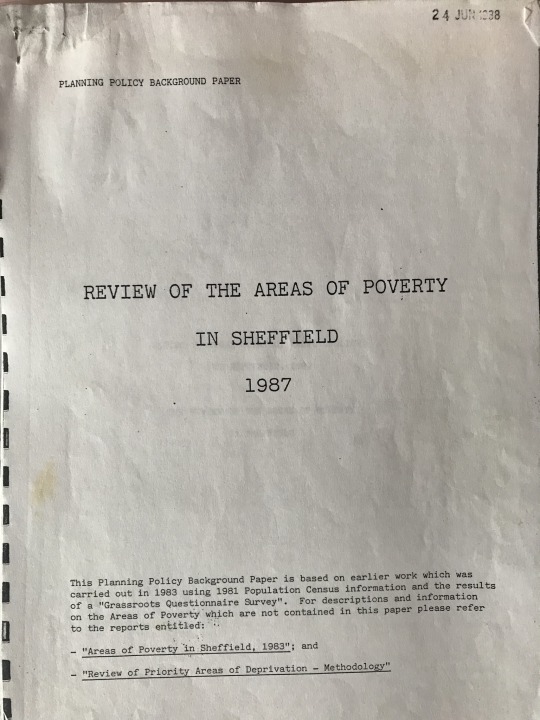
Netherthorpe and Upperthorpe
Netherthorpe is a suburb of Sheffield. It is one mile (1.6 km) west of the city centre. It is mostly an area of local government built housing situated on a considerable slope running downhill from the Brook Hill roundabout, at a height of 350 feet (107m), towards the Shalesmoor roundabout at a height of 160 feet (50m) over a distance of half a mile (1 km). It is bounded by the suburbs of Upperthorpe to the north, Crookesmoor to the west and the dualled Inner Ring Road (Netherthorpe Road) to the east. The suburb falls within the Walkley ward of the City.
Etymology
The newly created 1850s suburb, built on previously open moorland, was named by town planners who proposed 'Netherthorpe' to complement the adjoining, long established suburb of Upperthorpe - an area of some antiquity, founded by the Vikings as a settlement in the 9th century.
Redevelopment
Demolition of Netherthorpe's Victorian terraced housing began in 1956, with no consultation of those living there, most of whom were dispersed across the city to estates in other areas. While appreciating having upgraded facilities such as indoor bathrooms, there was also sadness at the loss of a close-knit community. It was part of a complete redevelopment over an area of 48.5 hectares, under the auspices of City Architect, J. L. Womersley. St Annes Church on Hoyle Street was demolished in the latter stages of the renewal. The new dwellings, constructed in phases between 1959 and 1972, were mostly Local Authority built tower blocks and three and four storey maisonettes. The high blocks were sited overlooking open space while the low blocks were grouped to form a series of interlinked courtyards with pedestrian paths around the buildings. Smaller flats were provided in the lower buildings to facilitate older people living close to their grown up families. The four tower blocks, completed in 1962, with the postal addresses of Brightmore Drive or Mitchell Street, were given the individual names of Adamfield, Cornhill, Robertshaw and Crawshaw. Two of the tower blocks have 14 storeys while the other two have 12. They were improved and re-clad in a blue and cream colour scheme in 1998. Some of the maisonettes were pulled down in the early part of the 21st century and replaced by conventional houses. When the Victorian terraced houses were demolished in the 1950s an area of parkland known as The Ponderosa was created as a recreation area for Netherthorpe and the adjoining suburb of Upperthorpe.
Netherthorpe has a population of around 3,000 with the 2003 Population Health Register giving an official number of 2,925. The ethnic breakdown shows that the suburb has much higher percentage of non-white people living within it than the Sheffield average with a high number of mixed race, Asian, Black and Chinese people living in the suburb, the high number of students in the area is the main contributing factor in this. Statistics class Netherthorpe as a Most Deprived area with 30% of households claiming income support compared to the Sheffield average of 17%. There is an unemployment rate of 10.4% compared to the city average of 4.2%. In housing statistics, 75% of residents live in flats, maisonettes or apartments compared to the Sheffield average of 18%. 65% of Netherthorpe properties are rented from the local authority compared to the city average of 26% while only 15% of the population are owner occupiers of their house.
Modern developments
One of the most significant contemporary developments in Netherthorpe has been the creation of the Sheffield Supertram light rail transport system in 1995 which has given the suburb excellent transport links as it stands on both the blue and yellow routes. The suburb has its own station on Netherthorpe Road which is on the central reservation of the dual carriageway and access is by a subway, which is limited by chicane barriers. A signed cycle route passes through the underpass, though the barriers prevent this being used by cycles or mobility aids which are not able to negotiate the barriers. Netherthorpe's close proximity to Sheffield University has always meant that the suburb has had a large concentration of students living within it. In 2009, the Opal 3 complex was built on Hoyle Street with accommodation for 992 students with leisure facilities and disabled access. Located within Opel 3 is the English Language Teaching Centre which is part of Sheffield University and helps students who are having problems with the English language.
0 notes
Text
Famous People From Yorkshire
For context, today (1st of August) is Yorkshire day! Yorkshire is the largest county in england and is located in the north of England.
The Brontë Sisters

The Brontës were a nineteenth-century literary family, born in the village of Thornton and later associated with the village of Haworth in the West Riding of Yorkshire, England. The sisters, Charlotte (1816–1855), Emily (1818–1848), and Anne (1820–1849), are well known as poets and novelists. Like many contemporary female writers, they originally published their poems and novels under male pseudonyms: Currer, Ellis, and Acton Bell. Their stories immediately attracted attention for their passion and originality. Charlotte's Jane Eyre was the first to know success, while Emily's Wuthering Heights, Anne's The Tenant of Wildfell Hall and other works were later to be accepted as masterpieces of literature.
Barbara Hepworth

Jocelyn Barbara Hepworth was born on 10 January 1903 in Wakefield, West Riding of Yorkshire, the eldest child of Gertrude and Herbert Hepworth. Her father was a civil engineer for the West Riding County Council, who in 1921 advanced to the role of County Surveyor. Hepworth attended Wakefield Girls' High School, where she was awarded music prizes at the age of 12 and won a scholarship to study at the Leeds School of Art from 1920. It was there that she met her fellow Yorkshireman, Henry Moore. They became friends and established a friendly rivalry that lasted professionally for many years. Her early work was highly interested in abstraction and art movements on the continent. In 1931, Hepworth was the first to sculpt the pierced figures that are characteristic of both her own work and, later, that of Henry Moore. They would lead in the path to modernism in sculpture. In 1933, Hepworth travelled with Nicholson to France, where they visited the studios of Jean Arp, Pablo Picasso, and Constantin Brâncuși. Hepworth later became involved with the Paris-based art movement, Abstraction-Création. In 1933, Hepworth co-founded the Unit One art movement with Nicholson and Paul Nash, the critic Herbert Read, and the architect Wells Coates. The movement sought to unite Surrealism and abstraction in British art.
Dame Judy Dench

Actress Dame Judi Dench is known for her roles in many James Bond films including Casino Royale and Skyfall, as well as The Best Exotic Marigold Hotel. Dame Judi was born in York, North Yorkshire.
Sir Patrick Stewart

Sir Patrick Stewart is an actor, best known for his roles in the X-Men film series as Charles Xavier. He was born in Mirfield, West Yorkshire.
Jodie Whittaker

Jodie Whittaker shot to fame after her role in Broadchurch, and now plays the Doctor in Doctor Who, she is set to depart the role after a trio of specials in Autumn 2022 . She's from Skelmanthorpe, West Yorkshire.
Matthew Lewis

Matthew Lewis became a household name at the age of 12 for his portrayal of Neville Longbottom in the Harry Potter film adaptations. He was born in Leeds, West Yorkshire.
Louis Tomlinson

Louis Tomlinson is best known as one-fifth of boyband One Direction, but now he's a successful solo artist! He was born in Doncaster, South Yorkshire.
Elizabeth Henstridge

Elizabeth Henstridge is an actress from Sheffield, South Yorkshire, best know for her role as Agent Jemma Simmons in Marvel's Agents of S.H.I.E.L.D.
Yungblud

Dominic Richard Harrison (born 5 August 1997), known professionally as Yungblud (stylized YUNGBLUD), is an English singer, songwriter, and actor. He's from Doncaster, South Yorkshire.
@she-nuwanda is this good? I hope it's alright.
#yes i copied this off Wikipedia don't come for me#if you're from England then i highly recommend the hepworth museum in Wakefield#it's a lovely day out#not dps#yorkshire#yorkshire day#never knew matthew lewis was from leeds#AYYYY#i love Elizabeth Henstridge how could i not include her#i could do more but I'm gonna end here :)
24 notes
·
View notes
Note
wait i wanna here about your slender campaign town so badly -🐌
Oh hell yeah thank you Snail
So we've got Sheffield, Ohio, and it was founded in the 1740's by this guy, Jeffery Braun, who was from a German aristocratic family and had a little bit of a problem in the fact that he was being stalked by slenderman. So he flees from Germany to France to try and escape it through an arranged marriage with this woman Mary Sheffield. Not great. But it has an upside. In the fact that he meets her brother, one Bruno Sheffield, who is an architect working on plans for a town in America, if only he could find the right sponsor.
So Braun falls in love with this guy instantly. And, having realized that France was apparently not far enough to get him away from the monster plaguing him, he decides to found this town with Bruno, drags his whole family across the fucking ocean and out into the middle of fucking Ohio. He names the town Sheffield, and for all of history people think it was named for his wife Mary but really it was for Bruno.
The plot of land they live on was previously uninhabited, if not outright avoided by the natives in the area, and throughout the town's early history they are plagued by dissappearences, which folklore may lead some to believe may have been caused by some supernatural creature in the nearby canyon. The rate of dissappearences may or may not have been slightly helped by the fact that Bruno Sheffield may or may not have in fact been a vessel for our dear old friend Habit. Either way, the population of the town stays fairly low up until the industrial revolution, and even up into the modern day never exceeds 3000.
But what happened to Braun and Bruno? Well, Braun was still being haunted by slenderman, and his lover was being possessed by an entity who very much wanted to kill slenderman, so things seemed to be working out for him at least a little bit. That is. Until Habit begins demanding too much of him, making requests that put too much at risk, and they begin to disagree more and more. Braun can feel the end coming, even writes a letter to Bruno about it. And, after a scouting trip out to that canyon, Braun never comes back. Bruno does eventually come back, incoherent, covered in blood, babbling about Braun's death. He's tried for the murder even though they can never get a clear confession from him, and executed soon after.
Throughout it's history the town continues to have dissappearences, reports of 'bear attacks' out near the old canyon, and a hell of a lot of folk lore regarding whatever it is out there in those canyons, but over all things have slowed down.
5 notes
·
View notes
Text
RIBA Awards 2022 News
RIBA Awards 2018, Winning Buildings, Shortlist, UK Architecture, Links, Projects, Architects
RIBA Awards 2022
Royal Institute of British Architects: Prize Winners News – Architectural Information
27 Nov 2020
RIBA Awards in 2022
RIBA confirms 2021 and 2022 UK Awards programme plans
Friday 27th of November 2020 – The RIBA has today announced that the next call for UK awards entries will be next year – for the 2022 RIBA Awards.
The 2021 RIBA UK Awards (including Regional, National and the RIBA Stirling Prize) will be selected from the shortlist for the 2020 RIBA Regional, RIAS, and RSAW Awards.
The RIBA will continue to build on its rigorous eligibility and judging criteria, and, from the 2022 RIBA Awards, will require all project entries to have been in use for one year. This change will enable judges to assess projects with even more detail on their performance, more extensive client feedback, and a better understanding of how the project functions within its civic, communal and environmental context. It will also add greater focus to the sustainability criteria – further aligning them with the standards set out in the RIBA 2030 Climate Challenge.
RIBA President Alan Jones said:
“I am pleased that the 2021 RIBA UK Awards will focus on judging and celebrating the exceptional projects that we were unable to visit this year. Not only is this the fairest outcome – reached after detailed consultation with entrants and jurors – but it provides an unexpected opportunity for us to bring forward plans to significantly refresh our judging criteria – with projects having to be in use for one year. The RIBA and our members are committed to the best, sustainable design that will serve generations to come, and I am pleased that from 2022 we will be able to further demonstrate this through our awards programme.”
Previously on e-architect:
May 2018
RIBA Awards in 2018
RIBA National Awards Winners in 2018
RIBA South East Awards Winners 2018
photo © Quintin Lake
RIBA East Awards Winners 2018
photo © Nick Kane
RIBA Yorkshire Awards Winners in 2018
photo © Phil Grayston
RIBA North East Awards Winners 2018
RIBA West Midlands Awards Winners 2018
RIBA International Award in 2018
RIBA Awards for International Excellence 2018
RIBA National Awards Shortlists in 2018
Arranged by region, alphabetical:
RIBA East Awards Shortlist 2018
RIBA London Awards Shortlist 2018
RIBA North East Awards Shortlist 2018
RIBA North West Awards Shortlist 2018
RIBA South Awards Shortlist 2018
RIBA South East Awards Shortlist 2018
RIBA West Midlands Awards Shortlist 2018
RIBA Yorkshire Awards Shortlist in 2018
23 + 22 Jun 2017
RIBA Awards in 2017
RIBA National Awards Winners in 2017
49 projects across the UK have been announced as winners in the 2017 National Awards for architecture, which distinguishes the UK’s most outstanding buildings and offers insight into construction, design, and investment trends in the country.
A shortlist for the prestigious Stirling Prize will be selected from this list.
Arranged by region:
RIBA East Awards Winners in 2017
• Carrowbreck Meadow by Hamson Barron Smith – Norwich, Norfolk, England – Housing development – private
photo © Jefferson Smith
• The Enterprise Centre, University of East Anglia by Architype – Norwich, Norfolk, England – University
photo © Nick Caville
• Peacock House by BHSF Architekten with Studio-P Aldeburgh, Suffolk, England – Individual house
photo © Benedikt Redmann
• St Albans Abbey by Richard Griffiths Architects – St Albans, Hertfordshire, England – Place of worship
photo © Richard Griffiths
• Vajrasana Buddhist Retreat Centre by Walters & Cohen Architects Walsham le Willows, Suffolk, England – Place of worship
photo © Dennis Gilbert – VIEW
Vajrasana Buddhist Retreat Centre Building in Suffolk
• The Welding Institute Eric Parry Architects Great Abington, Cambridge, England Research institution
photo © Dirk Lindner
The Welding Institute Building
• Leicester Cathedral’s Richard III Project ‘With Dignity and Honour’ by van Heyningen and Haward Architects – Leicester, England – Place of worship
photo © Carlo Draisci
RIBA London Awards Winners in 2017
• The Laboratory, Dulwich College by Grimshaw – Dulwich, south London, England School – independent/public
• No 49 by 31/44 Architects – Hither Green, southeast London, England – Individual House
• The Loom by Duggan Morris Architects – Whitechapel, east London, England – Workspace/office
• 8 Finsbury Circus by WilkinsonEyre – City of London – Workspace/office
image courtesy of architects
8 Finsbury Circus
• 40 Chancery by Lane Bennetts Associates – Holborn, central London, England – Mixed use building – Workspace/office and retail
photo ® Hufton+Crow
Saatchi & Saatchi Chancery Lane HQ
• King’s College School by Allies and Morrison – Wimbledon, southwest London, England – School – independent/public
• New Scotland Yard by Allford Hall Monaghan Morris – Embankment, central London, England – Workspace/office
picture from London Metropolitan Police Service
New Scotland Yard by Allford Hall Monaghan Morris
• Paradise Gardens by Lifschutz Davidson Sandilands – Hammersmith, west London, England – Housing development – private
• Photography Studio for Juergen Teller by 6a architects – Ladbroke Grove, west London, England – Mixed use building – workspace and residential
photo © Johan Dehlin
Photography Studio for Juergen Teller wins a RIBA Award 2017
• Silchester by Haworth Tompkins – Notting Hill, west London, England – Housing development – social
• Barretts Grove by Amin Taha + Groupwork – Stoke Newington, north London, England – Housing development – private
photo © Timothy Soar
Barretts Grove wins a RIBA Award in 2017
• Dujardin Mews by Karakusevic Carson Architects with Maccreanor Lavington – Ponders End, north London, England -Housing development – social
• Tate Modern’s Blavatnik Building by Herzog & de Meuron – Bankside, central London, England – Museum
Switch House, Tate Modern © Iwan Baan
Tate Modern Blavatnik Building by Herzog & de Meuron
• The British Museum World Conservation and Exhibitions Centre by Rogers Stirk Harbour + Partners – Bloomsbury, central London, England – Museum
image © the Trustees of the British Museum
British Museum World Conservation and Exhibitions Centre / British Museum World Conservation and Exhibitions Centre
• Walmer Yard – P Salter and Associates with Mole Architects + John Comparelli Architects – Holland Park, west London, England – Housing development – private
RIBA North East Awards Winners in 2017
• Live Works by Flanagan Lawrence with Tench Maddison Ash Architects – Newcastle Upon Tyne, England Theatre
Live Works Newcastle Building
• Shawm House by MawsonKerr Architects – West Woodburn, Northumberland, England – Individual house
• The Word by FaulknerBrowns Architects – South Shields, South Tyneside, England – Library and cultural venue
RIBA North West Awards Winners in 2017
• Chetham’s School of Music – Stoller Hall by stephenson STUDIO – Manchester, England School – independent/public
photograph © Daniel Hopkinson
Chetham’s School of Music Building
• Finlays Warehouse by Stephenson Studio – Northern Quarter, Manchester, England Housing development – private
• Liverpool Philharmonic by Caruso St John Architects – Liverpool, England – Theatre
• Maggie’s at the Robert Parfett Building by Foster + Partners – Christie Hospital, south Manchester, England – Healthcare
photograph © Nigel Young / Foster + Partners
Maggie’s at the Robert Parfett Building
RIBA Northern Ireland Awards Winners in 2017
• Fallahogey Studio by McGarry-Moon Architects Ltd – Kilrea, Northern Ireland – Workspace/office
photo : Adam Currie
RIBA South Awards Winners in 2017
• Bedales School of Art and Design Building by Feilden Clegg Bradley Studios – Petersfield, Hampshire, England School – independent/public
photograph © Hufton+Crow
• The Berrow Foundation Building and New Garden Building, Lincoln College by Stanton Williams University of Oxford – Oxford, England – University
photograph © Nick Hufton
• Magdalen College Library by Wright & Wright Architects – University of Oxford, Oxford, England – University
photograph © Dennis Gilbert
• Warwick Hall Community Centre by Acanthus Clews Architects – Burford, Oxfordshire, England – Community space
photograph © Andy Marshall
RIBA South East Awards Winners in 2017
• Caring Wood by Macdonald Wright Architects Rural Office for Architecture – near Maidstone, Kent, England – Individual house
• Command of the Oceans by Baynes and Mitchell Architects – Chatham Historic Dockyard, Kent, England – Museum
photo : Hélène Binet
Command of the Oceans in Chatham
• Hastings Pier by dRMM Architects – Hastings, East Sussex, England – Leisure
photo : Alex de Rijke
Hastings Pier Building
• British Airways i360 by Marks Barfield Architects – Brighton & Hove, England – Leisure
British Airways i360 Drone image : Visual Air
British Airways i360 Building
• South Street by Sandy Rendel Architects Ltd. – Lewes, East Sussex, England – Individual house
RIBA South West Awards Winners in 2017
• Dyson Campus Expansion by WilkinsonEyre – Malmesbury, Wiltshire, England – Workspace/office
• New Music Facilities for Wells Cathedral School by Eric Parry Architects – Wells, Somerset, England School – independent/public
image : Smoothie
New Music Facilities for Wells Cathedral School
• Wolfson Tree Management Centre by Invisible Studio – Westonbirt Arboretum, Gloucestershire, England – Leisure
RIBA North Awards Winners in 2017
• Remembrance Centre, National Memorial Arboretum by Glenn Howells Architects – Lichfield, Staffordshire – Memorial
• Blackburn Meadows Biomass by BDP – Sheffield, South Yorkshire, England – Energy infrastructure
• Derwenthorpe Phase One by Studio Partington – York, north Yorkshire, England – Housing development – private
• Victoria Gate Arcades by ACME – Leeds city centre, England – Retail
RIAS Awards Winners in 2017
• City of Glasgow College by Reiach and Hall Architects and Michael Laird Architects – Cathedral Street, Glasgow, Scotland – Further education college
City of Glasgow College Building
• Newhouse of Auchengee by Ann Nisbet Studio – Meikle Auchengree, North Ayrshire, Scotland – Individual house
• Rockvilla by Hoskins Architects – Speirs Wharf, Glasgow, Scotland – Workspace/office
RIBA president Jane Duncan said,
“The lack of high-quality new housing is a huge issue in the UK so I am particularly pleased to see great examples of well-designed, sustainable new homes amongst our award winners,” she added.
“We all deserve a well-designed, affordable home, wherever we live in the country. I encourage other local authorities, developers and clients to look at these projects as exemplars.”
She praised the inclusion of a number of high-quality schools – including The Laboratory at Dulwich College and new music facilities at Wells Cathedral School – but said it was disappointing to see no new state school buildings included in this year’s awards.
“Well-designed schools support improved student achievement, and staff and student wellbeing and should be part of educational aspirations for all our schools, not just those in the fee-paying sector,” she said.
——————————————————————————–
8 Apr 2017
RIBA Awards Shortlists 2017
RIBA Awards Shortlists in 2017
The winners will be announced at an Awards event at Ascot Racecourse on Thursday 25 May.
RIBA London Awards 2017
RIBA West Midlands Awards 2017
RIBA South East Awards 2017
RIBA South Awards 2017
RIBA South West Awards 2017
RSAW Welsh Architecture Awards 2017
RIBA East Awards 2017
RIAS Awards 2017 Shortlist
RIBA Northern Ireland Awards 2017
——————————————————————————–
14 Jul 2016
RIBA Stirling Prize 2016 Shortlist
23 Jun 2016
RIBA Awards 2016 Winners
RIBA National Award Winners 2016
The UK’s best new buildings
RIBA Awards 2016
The Royal Institute of British Architects (RIBA) has today, Thursday 23 June, announced the winners of the 2016 RIBA National Awards, the most rigorous and prestigious awards for new buildings in the UK.
RIBA National Award-winning buildings set the standard for good architecture. The shortlist for the coveted RIBA Stirling Prize for the UK’s best building of the year will be drawn from the 46 award-winning buildings announced today.
image : Timothy Soar
RIBA Awards Past Winners
RIBA Awards 2013 – Winning Buildings + Architects
RIBA Awards 2013
photograph © Studio cento29
Britain’s 50 best new buildings – 2012 RIBA Award winners
RIBA Awards 2012
photograph © Hufton+Crow
Location: UK
Winners Archive
RIBA Awards 2011
photograph © Tim Soar
Stirling Prize
RIBA Special Awards Shortlist – Client of the Year award + Stephen Lawrence Prize
RIBA International Awards : Winners
photo : Patrick Bingham-Hall
RIBA Special Awards
RIBA Royal Gold Medal
RIBA Awards Scotland
Architecture
Previous Winners 2005 – 2010
RIBA Awards 2010
RIBA Awards 2009
RIBA Award 2009 Scotland – Scottish winners
RIBA Awards 2008 – winners online
RIBA Awards Scotland 2008
RIBA Awards 2007
RIBA Awards 2006
RIBA Awards 2005
RIBA Awards – Past Overall National Winners
RIBA Award 1992 : Sackler Gallery
RIBA Award 1991 : Broadgate Centre
RIBA Award 1990 : Queen’s Inclosure Primary School, Hampshire
RIBA Award 1989 : Nelson Mandela School, Birmingham
RIBA Award 1988 : St Oswald’s Hospice, Newcastle
RIAS Award for Architecture – Best Building in Scotland
Comments / photos for the RIBA Awards 2022 – UK Architecture Prize page welcome
The post RIBA Awards 2022 News appeared first on e-architect.
4 notes
·
View notes
Text
FOMA 26: UK Post War Experiments
Ross Nesbitt has chosen post war Forgotten Masterpieces in the UK according to their influence, innovation, but above all how they have interacted with the people using them.

Scottish Secretary Willie Ross and his wife at the opening of the Red Road flats in Glasgow (1964). | Photo via Read Road Pinterest
Each building illustrates how the response of the Modern Movement to the challenges of reconstruction and planning in post-WW2 era Britain touched on many aspects of daily life: religion, education, retail, work and transport. And they all divide public opinion.
Starting with the original medieval Coventry Cathedral, destroyed by the Luftwaffe on 14 November 1940 in an air raid code-named Moonlight Sonata.
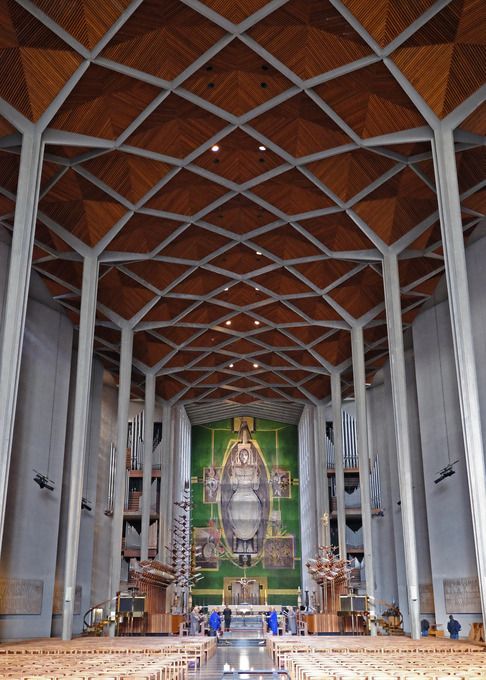
Rebuilding of the cathedral started in 1955, and by the time of the consecration it had become a symbol of hope and reconciliation. | Photo by Ross Nisbet
The attack targeted Coventry's industry, but it was clear that collateral damage and casualties would be considerable. The city was hit by 200 bombs and among many buildings also the cathedral fell. Only the tower, spire and outer wall survived.
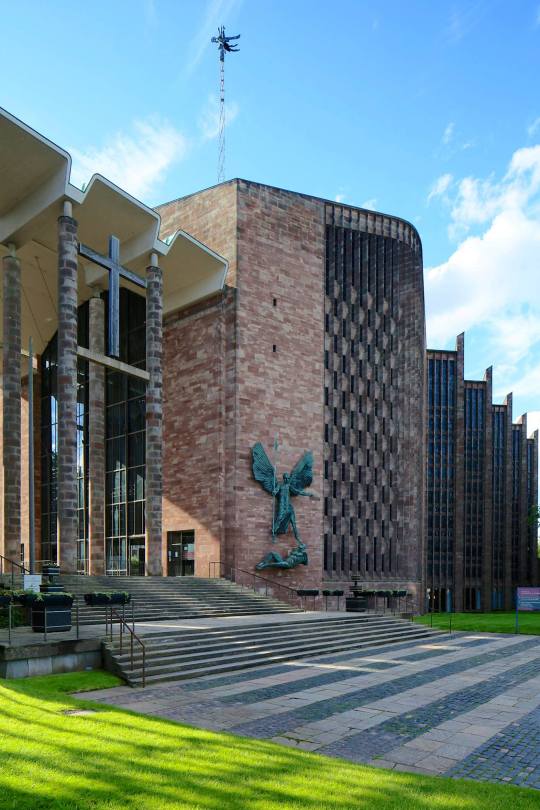
Sir Basil Spence was the only architect to insist that the ruins of the old cathedral should remain intact. | Photo via The Twentieth Century Society
The morning after Provost Richard Howard wrote in chalk on the sanctuary walls “Father, Forgive.” On Christmas 1940 the BBC Home Service broadcast Howard’s message from the cathedral ruins. Howard’s gesture of forgiveness inspired Spence, which was chosen from over 200 architects in a competition in 1951 to design a new cathedral.

From Priory Street we find Sir Jacob Epstein’s large sculpture of Archangel Michael triumphing over the Devil. | Photo by Ross Nesbitt
The main body of the new cathedral is built from red Hollington sandstone, in unity with the ruins of the old. A high porch links them. Zigzag walls with angled windows direct light down the nave onto the altar. The floor is of polished fossil stone. Large artworks commissioned by Spence include stunning abstract stained glass windows by John Piper and Patrick Reyntiens and a tapestry behind the main altar by Graham Sutherland, thought to be the largest in the world.
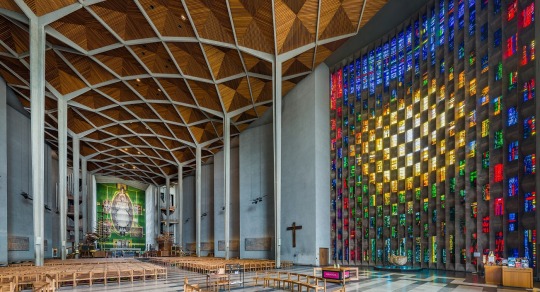

The Charred Cross emphasize the reconciliation theme. | Photo by Ross Nesbitt
After the bombing, cathedral stonemason Jock Forbes noticed two burned wooden roof beams had fallen in the shape of a cross. He tied them together, forming an altar which Spence preserved on the stairs between the new and old part of the cathedral. Provost Howard took three nails from the smouldering beams to make the Cross of Nails, which became the centerpiece of the altar cross in Spence’s new cathedral.
Spence’s design draws effectively from the cathedral’s history and post-war mission. It’s an uncompromisingly modern construction but also perfectly integrated with its past. Coventry Cathedral shows the visitor the waste and loss of war without flinching, but is not a forbidding structure. Wood is used to great decorative and functional effect, giving warmth and human scale to the nave and choir. The Gethsemane chapel highlights Spence’s talent for juxtaposition and interaction: the visitor passes Spence’s harrowing crown of thorns icon to enter a warm sanctuary beneath war artist Steven Sykes’ dazzling angel mosaic in gold leaf and blue tile.

The Roger Stevens Lecture Theatre is the centerpiece of the complex of buildings for the Leeds University campus. | Photo by Ross Nesbitt
Britain saw a great expansion in education as the post-war generation grew up. The number of students and universities nearly doubled from 1960s to 1970s. Chamberlin, Powell and Bon, who had just completed the acclaimed Golden Lane Estate, were engaged as Master Planners at the University of Leeds to oversee in-house architect Geoffrey Wilson and provide expertise to the expansion of the campus. They produced a plan in two phases. An initial report recorded their enquiries and research into the existing campus and set out their vision for the new campus. It summarized the anticipated problems and posed solutions, specifying the required materials, time, space and costs. A second Development Plan focused on the maths and science precinct and features the Roger Stevens Lecture Theatre.
The design was a forward-looking city within a city, and in many ways an important trial run for the Barbican estate. The Development Plans saw Chamberlin, Powell and Bon experimenting with ideas about the principles of urban design, the integration of community and environment into a cohesive whole, and the most economic and adaptable use of space. The plans generated interest at an international level and were influential to the modern movement as a body of research and a definitive model for the modern university campus.
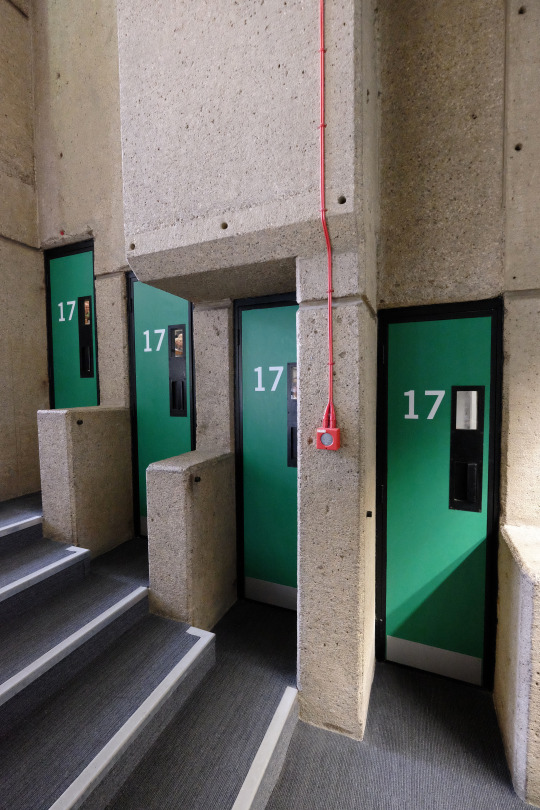
The building’s unconventional configuration of space does require a bit of thought to learn its signage and color coding. | Photo by Ross Nesbitt
The building contains 25 tiered lecture theaters with different capacities, a refectory and reprographics facilities. The exterior is futuristic and striking, compared to a church organ, robot or car engine by students. The refectory overlooks a lake, which is more than ornamental as it was designed to provide air conditioning for the building, same idea architects developed on a bigger scale with the Barbican Lake. The layout is deceptively simple, two gently sloping staircases link the lecture theaters and each row of seats has its own individual door, ensuring lectures are not interrupted by latecomers. Its listed status ensures the Roger Stevens Lecture Theatre's future is safe. It's another divisive building but maybe it's just waiting for the rest of us to catch up with it.

An early example of pedestrian planning, Castle Market was a multi-level complex that made maximum use of a compact site. | Photo by Ross Nesbitt
Castle Market built in stages between 1959 and 1965 was named after Sheffield Castle. It was almost entirely demolished in 1648 but the remains of the foundations are visible beneath the market. Like Park Hill and Gleadless Valley, Castle Market was a thoughtful and rewarding design, which made great use of Sheffield's famous hills and valleys. Womersley and Darbyshire recognised what made Sheffield an interesting place to build was its slopes and dips, and created a complex with soaring heights (the walkways and Rooftop Cafes) and three labyrinthine floors of markets below, all with access to the street on different levels of the Castle Hill.
Inside, Castle Market was closer to a modernist re-imagining of Istanbul's Grand Bazaar than the blandly interchangeable malls of today. It was a treasury of mid-century modern mosaics, signage and tile designs, geometric and multi-coloured in seemingly endless variety. Layer upon layer of design eras cried out from every stall, competing for the shopper's attention. Although postmodern signage was added to the walkways in the 1980s, most of Castle Market retained its original 1960s signage, including many classic "formica cafes" - one was used as a location in Shane Meadows' "This is England '88". The ascent to the Roof Top Café, with its sci-fi suspended ceiling and net curtains, offered stunning views of the city.

In Castle Market working class people bought groceries, met friends, drank tea and a gossipped. | Photo via English Cathedrals Archive
Pulp singer Jarvis Cocker had his first job there as a teenager, on John Firth's fish stall. But not everyone appreciated Castle Market. Redevelopment had been planned as early as 1996 by Sheffield City Council, who wanted to expose the remains of the castle walls in a visitors' centre.
dailymotion
And of course, the surrounding area would be purged in the name of regeneration. This act of social cleansing did not go unopposed. An anonymous request for listed status for Castle Park was made in 2011. Sheffield's Liberal Democrat City Council responded by trying to start a letter writing campaign in favour of demolition. English Heritage rejected the application: "In order to be considered for listing, 20th Century market halls should display a high degree of architectural, technological and historic interest. Those post-war market halls which have already been listed (such as Coventry) have particularly high levels of architectural innovation and artistic achievement which justify the designation of such late buildings.This is not shared by Castle Market in Sheffield."
Anyone familiar with both Coventry Market and Castle Market would agree that this comparison was patently false. Trading ceased in November 2013 and Castle Market was demolished in 2015. The markets were relocated to The Moor, on the opposite side of town. The new market is the kind of forgettable development that could have been built for any town in the UK.

The Spence’s project of a government office building in central London could not be more different to Coventry Cathedral. | Photo by Ross Nesbitt
After the Second World War, civil servants in London’s Whitehall were working in cramped offices built in the 19th century when government administration was smaller. With the post-war expansion of the British state, office space was needed outside the historic core of Whitehall. New offices on Queen Anne’s Gate were first planned in 1959, but the original plan of a more conventional tower block was rejected by the Royal Fine Art Commission. Planning permission for Spence’s revised design was given by the Westminster Planning Committee in 1969.
The building on 102 Petty France is in a sensitive location in central London: in view of Buckingham Palace, overlooking The Mall and two of the Royal Parks, St. James's Park and Green Park. Historically, the site was previously occupied by Queen Anne’s Mansions, London’s first high-rise housing, built from 1873-1890. Today, Victorian properties are desirable and the mansion flat format is fashionable again, but the Victorian and Edwardian media decried mansion flats as Babylonian, factory-like and out of scale with historic Georgian buildings. Londoners feared for the value of their property if a sunlight-blocking mansion flat was built nearby. At 12 storeys high, Queen Victoria complained that the Mansions blocked her view. The Mansions tested the limits of planning law, prompting the introduction of height restrictions in the London Building Acts of 1890 and 1894. During WW2, the Mansions were requisitioned as Government offices and retained until they were demolished in 1973. Many in Whitehall hoped the site would be developed with a building more sensitive to the surroundings. What was proposed shocked them.

The 102 Petty France personifies the qualities people love and hate about Brutalism in equal measure. | Photo by Ross Nesbitt
Several Members of Parliament were outraged by Spence’s model and sketches. On 4 July 1972, Lord Reigate, speaking in the House of Lords, asked the Government to intervene and halt building. Calling Spence’s design a mass of monumental masonry, he went on to predict “this unlovely lump of a building will loom over London for a long time, and will, if I may say so, if it is allowed to happen, outlive all your Lordships”. The Earl of Cork and Orrery added “Like the great Martian machines in H. G. Wells' War of the Worlds, the monsters are closing in.” Thankfully (for those of us who appreciate monsters), Lord Reigate failed.
102 Petty France is asymmetrical, angular and makes no concessions to the Georgian row houses of Queen Anne's gate. It’s a big, assertive building which succeeds in its job as a symbol of government authority and a landmark on the local skyline. Walking West from Westminster Abbey, the building draws the eye. From the North, the corner tower, resembling a knight’s helm, rises above the trees of St James’s Park. It also dominates the skyline of Green Park and is even visible from Hyde park. The heavy massing of the projecting first and second floors presents visitors with a striking bunker-like solidity. The Earl’s science fiction comparison is appropriate. The building has a unique personality lacking in most other London office buildings of the time. It’s more impactful than, for example, the works of Richard Seifert.

102 Petty France was designed as flexible office space around three cores, modification of the structural frame proved unnecessary. | Photo via Wikimedia
When the Home Office decided to move to a new headquarters in 2003, the cost of demolition outweighed traditionalists’ calls to demolish 102 Petty France. Extensive modifications were made for its current occupants, the Ministry of Justice. The building was refurbished to accommodate 2,400 staff. A multi-services chilled beam system was installed to upgrade office services. The modifications left the original character of Spence’s design intact and 102 Petty France is now an excellent example of how a Brutalist building can be recycled for the modern era.

A structure that is hard to love, but historically important and symbolic of changes in British society since it was built. | Photo via Leicester City Archive
Today, Lee Circle car park appears totally unremarkable to the casual observer, but the Tesco store and car park that opened there in in 1961 was a pioneering experiment, noteworthy for many reasons. A crowd of over 2,000 turned up to see Sid James, star of the Carry On films, open the store in 1961. The supermarket was the chain’s first expansion outside the Southeast. It entered the Guinness Book of Records as the largest store in Europe. Combining a supermarket and a homewares store, with the six-tier Auto-Magic multi-storey car park above providing space for 1050 cars, this was an entirely new retail format in the UK. The opening of the store marked the beginning of self-service shopping in the UK: for the first time, customers could browse alone, filling their own baskets or trolleys. The car park was the first in Europe to be fully automated using coin-operated barriers. Customers refuelled at the forecourt petrol station and used the (also automated) car wash. This was shockingly modern stuff for 1961 but it would become the norm over the next decade. It also illustrates the extent to which the car was prioritized in British town planning at the time, which would be a key factor in Lee Circle’s eventual decline.

The store and car park were integrated so that staff could take customers’ purchases directly to their cars. | Photo via Leicester City Archive
Details of the architect are elusive, but Lee Circle’s double-helix design (where cars ascend on one spiral ramp and descend on another, without meeting) shows they were probably inspired by the Fiat Lingotto Factory, designed by naval engineer and architect Giacomo Matté-Trucco in 1923.
The efficiency of Lee Circle’s double helix design meant that even at the peak of its popularity in the mid -1960s, queues were rare. The same cannot be said for car parks using the grid system. The complex also housed a bowling alley which featured in Ray Gosling's 1964 film 'Two Town Mad' (comparing Leicester and Nottingham), illustrating Leicester’s status as a truly modern city.
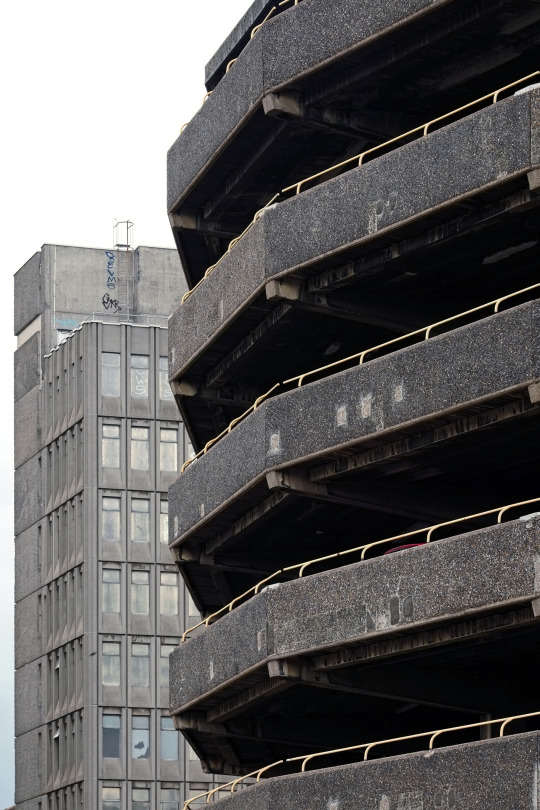
Lee Circle certainly presents a flowing maritime profile, like Streamline Moderne stripped down to the bones. | Photo via Leicester City Archive
The Tesco store closed in the early 80s (today the unit is occupied by a fabric wholesaler) but the car park remains, its concrete weathered and patched. It is still open but under-used. Shoppers were drawn back to the historic centre of Leicester by the Haymarket Shopping Centre (1973) and the Shires Centre (1991), both of which offered parking, and importantly, convenient access to newly pedestrianised shopping streets. The nearby county court and benefits office closed in 2007, reducing demand for parking further. The future of Lee Circle is under threat. Its opening was probably the heyday of this underdeveloped quarter of Leicester, where Joseph Merrick, the Elephant Man, was born a hundred years before the car park.
–
#FOMA 26: Ross Nesbitt
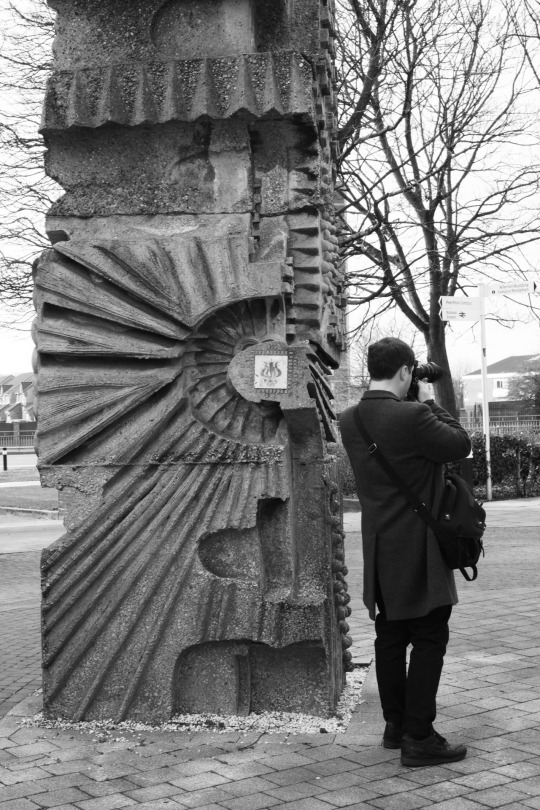
Ross Nesbitt was born in Scotland and lives in Nottingham, England. He likes to take photographs and has posted his work on Scavengedluxury since 2010.
80 notes
·
View notes
Photo

Brutalist Buildings Large D, Yellow (stoneware ceramic) by @easterlyartists member @fionashreeve Fiona Shreeve Brutalist Architecture and Mass Housing provide the imagery from which Fiona creates geometric and architectural sculptural forms. Modernism, starting with Le Corbusier’s, “Unite d’Habitation", was followed by idealistic architects designing modern “streets in the sky” such as Park Hill, Sheffield and The Barbican complex. Her work is created from the photographs and images of these buildings, which are used to create a narrative combining ceramic forms, surface prints and colour. ------------- #fionashreeve #easterlyartists #britishartists #contemporaryceramics #modernartists #visualartwork #suffolkart #suffolkartist #suffolkartists #lowestoftart #feriniartgallery #pakefield #ceramics #ceramicart #ceramicartist #pottery #potteryart #stonewarepottery #stonewareceramics #brutalistart #brutalistdesign #brutalistsculpture #abstractartwork #abstractartworks #abstractartists #evocativeart #linesandshapes #markmakingdesign #slipcast (at Lowestoft) https://www.instagram.com/p/CWXk-aLDLBr/?utm_medium=tumblr
#fionashreeve#easterlyartists#britishartists#contemporaryceramics#modernartists#visualartwork#suffolkart#suffolkartist#suffolkartists#lowestoftart#feriniartgallery#pakefield#ceramics#ceramicart#ceramicartist#pottery#potteryart#stonewarepottery#stonewareceramics#brutalistart#brutalistdesign#brutalistsculpture#abstractartwork#abstractartworks#abstractartists#evocativeart#linesandshapes#markmakingdesign#slipcast
0 notes
Text
Standing Seam Metal Roofing Manufacturers- Aditya Profiles
Standing seam metal roofs are gaining popularity due to their superior waterproof qualities, sleek/modern look, and how long they are expected to last. Learn more about the benefits, disadvantages, and uses of this prominent metal roof type.

The metal roof is an umbrella term that covers a wide range of roofing options, products, and choices.
When someone refers to "metal roofing," they could be talking about metal shingles or shingles, a roofing system with exposed fasteners that is common for farm buildings, or maybe even a standing seam metal roofing system.
Of all the types of metal roofing, standing seam is becoming increasingly popular as homeowners seek products that last a long time, look modern, and protect their structure.
However, how much do you know about standing seam metal roofing?
At Sheffield Metals, we pride ourselves on being a leading provider of standing seam metal wall and ceiling systems for architects, contractors, fabricators, and home/building owners. In other words, we know raised seam metal roofs.
For more information visit Aditya Profiles
0 notes
Text
Godwin gets green light for 23-storey rental flats scheme
Developer Godwin has got the planning green light for a 336 build-to-rent apartment scheme on the edge of Sheffield city centre.
The development, named The Meridian, will be built close to Sheffield’s train station at a prominent 1.1-acre brownfield site on the corner of Farm Road and Queens Road, which has been vacant for many years.
Designed by local architect Bond Bryan The Meridian will comprise three stepped and interlocking buildings of 23, 17 and ten floors.
The scheme will consist of one, two and three-bedroom modern open-plan apartments, 94 private balconies.
It will also feature co-working spaces, residents’ lounge and gym, as well as landscaped roof garden.
James Mulcare, head of residential Capital Markets at Godwin Developments, said: “We are delighted to have received planning consent from Sheffield City Council for this scheme.
“The development is a major milestone for the BTR market in the city, bringing forward a multifunctional living space that is also perfect for working, relaxing and socialising.
“We are confident it will be a popular choice among residents of various age groups – and an attractive proposition for investors.”
0 notes
Text
Godwin gets green light for 23-storey rental flats scheme
Developer Godwin has got the planning green light for a 336 build-to-rent apartment scheme on the edge of Sheffield city centre.
The development, named The Meridian, will be built close to Sheffield’s train station at a prominent 1.1-acre brownfield site on the corner of Farm Road and Queens Road, which has been vacant for many years.
Designed by local architect Bond Bryan The Meridian will comprise three stepped and interlocking buildings of 23, 17 and ten floors.
The scheme will consist of one, two and three-bedroom modern open-plan apartments, 94 private balconies.
It will also feature co-working spaces, residents’ lounge and gym, as well as landscaped roof garden.
James Mulcare, head of residential Capital Markets at Godwin Developments, said: “We are delighted to have received planning consent from Sheffield City Council for this scheme.

“The development is a major milestone for the BTR market in the city, bringing forward a multifunctional living space that is also perfect for working, relaxing and socialising.
“We are confident it will be a popular choice among residents of various age groups – and an attractive proposition for investors.”

from https://www.constructionenquirer.com/2021/08/18/godwin-gets-green-light-for-23-storey-rental-flats-scheme/
0 notes
Text
Top Architecture Universities in the World

The skill and technology of designing and engineering big constructions is known as architecture. Those that want to study architecture are going to be curious about both the sciences and therefore the arts, and architecture admission criteria often take creative talent also as quantitative aptitude into account.
Architects construct projects suited to modern usage and are thus mainly conscious of safety and dependability; therefore students must be prepared to coach for a somewhat lengthy amount of their time before being fully functioning, licensed architects. Though architectural license laws vary by location, you'll often be required to spend a minimum of 5 years of education (bachelor's and academic degree levels) and two years of professional job experience.
What are you able to expect from an architecture degree?
Undergraduate architecture degrees will educate students on anything from how a beam operates to the way to precisely create 3D designs by hand and using computer applications. The bulk of your courses will most certainly be focused during a studio for creative work, with lectures and criticism courses thrown a certain good measure. Critique discussions, often referred to as crits in art and design training, are meetings during which a student displays work to instructors and classmates and subsequently receives criticism thereon work.
Enrolled students in architecture courses would also take classes on history, theory, and technology, also as computer-aided designing workshops aimed toward providing students with competency in several design programs to help them in completing specific projects. Essays, also as regular visits to notable structures and sites of architectural importance, also are required components of architecture degrees.
Top Architecture Universities in the World
Here is the list of best Architecture Universities in the world consistent with the QS World University Rankings (Subject Wise).
Massachusetts Institute of Technology (MIT), USA
The Delft University of Technology, Netherlands
The Bartlett School of Architecture, UCL (University College London), United Kingdom
ETH Zurich (Swiss Federal Institute of Technology), Switzerland
Harvard University, United States
The University of California, Berkeley (UCB), US
Politecnico di Milano, Italy
Manchester School of Architecture, UK
University of Cambridge, United Kingdom
Ecole Polytechnique Fédérale de Lausanne (EPFL), Switzerland
The UK is host to 19 of the world's finest architecture schools, including three of them ranked within the top ten within the QS World University Rankings for architecture. We now have the University of Sheffield and Cardiff University outside of the highest 10. This year, University College Dublin in Ireland ranks 101-150 within the research citations per publication metric.
This year, France has just one entry: University Paris 1 Panthéon-Sorbonne, which scores 151-200. This year, Spain features five rated universities, with Universitat Politècnica de Catalunya and Universidad Politécnica de Madrid both rating within the top 40, at 21st and 35th position, respectively.
Germany also performs better this year, with seven institutions appearing within the QS World
University Ranking for architecture this year : Technische Universität Berlin and Technische Universität München.
The University of Melbourne (17th position), the University of Sydney (joint 18th), RMIT University (25th), and the University of New South Wales (UNSW, 27th) are four of Australia's 15 entries in the subject standings for architecture this year.
New Zealand features two newcomers in the ranking list: the University of Auckland (51-100) and
Victoria University of Wellington, which moved up from 151-200 to 101-150.
Gotouniversity is the best study abroad consultant. We have been providing free admission counselling, application services and consultancy services all over the world for career counseling and admission guidance. If you are looking for Regents University London, visit our site.
0 notes
Photo


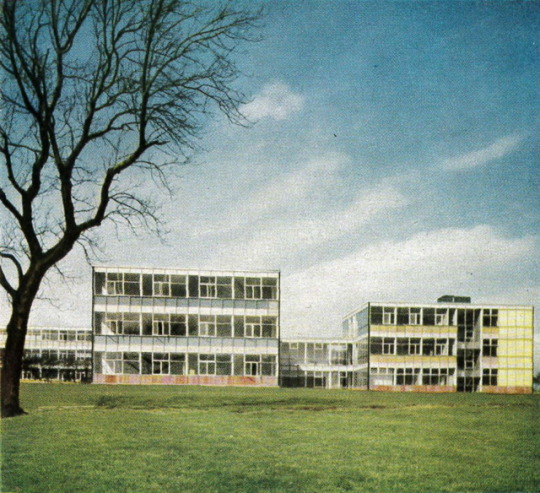
hurlfield girls secondary modern school, sheffield (demolished)
architects’ co-partnership. AR 1955
#hurlfield#sheffield modernist#sheffield school#secondary modern#modernist architecture#mid century architecture
254 notes
·
View notes
Text
Modern Architecture : a Learning for Architecture These Days
Modernism in architecture was indirectly brought out by the industrial revolution between 1750 and 1850 with the invention of the steam engine. Occurred in Europe and the United States, industrial revolution was a whole turning point for technology and led to the inventions of building’s material and architecture. First emerged in the early twentieth century, modern architecture began to gain reputations after World War II, after it contributed solutions to modern mass housing which meet basic social needs. Modern architecture used the function of the buildings as its strong base in terms of designing a building by the usages of newly invented materials, structural innovations, and elimination of ornaments.
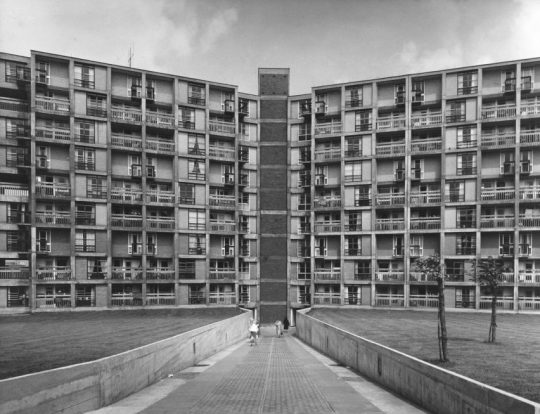
Post war housing : Park Hill Estate, Sheffield, by Jack Lynn and Ivor Smith
Designing purely based on a building's purpose became a strong principal in modern architecture. This principle leads to its formal aspect following how the building will be used. It constructed asymmetrical compositions, minimize ornaments used in the design, and tendency toward “plain” architecture with a neutral palette. Building’s materials used commonly are newly invented materials to those days, such as reinforced concrete, steel frames, plastic, ribbon windows and curtain walls. These building’s materials were applied raw and honest.
Modern architecture is considered as an era full of arrogant, ambitious and idealist architects in which they believed that a better architecture would be followed by a better world. Modernist architects around the post war era brought out their very own point of view and idealism, acted all high and mighty, and put their clients, users and even professionals excluded, even dragged them down, from their projects.
For example, Corbusier gave a statement about how a house must be “a machine for living in”. Home should have the purity of form of a well-designed machine to provide its function. Some modernist projects even came with furniture and more to tie down the design to not be changed by its future users. However, users need identity and comfort that might not be equal between one and another. This condition led the houses to lose its comfort and turned to ‘house’ rather than a ‘home’.

The fall of St. Louis Notorious Pruitt-Igoe Housing Project, also the fall of modern architecture
Moreover, modern architecture diminished the historical and cultural aspects to rebuild cities, resulting in major demolition of historical buildings or disrespectful building characteristics to its surrounding area.
Postmodern later emerged as a counter response to the failure of modern architecture. Started in the 1970s, post modern conveyed free-thinking movement with conceptual consideration to the surrounding environment. Learning from the modernism era, post-modern intended to rediscover classical architecture and apply them to modern structure. Postmodern used architectural language to send complex messages of the buildings. With the idea of free-thinking, it was hard to define which building is postmodern work.

Piazza d’Italia by Charles Moore, a postmodernism in architecture
Contradiction became the core thinking of postmodernism to embrace contextuality by mixing various styles and various elements from various eras to create unique architecture. It resulted in familiar looking buildings that somehow honored local history but had new visual appeal.
However, modern architecture is still described as the finest solutions for post war middle-class mass housing to solve social problems, such as slum and poverty. Even until now, the minimalism of modern architecture is still applied in social housing projects and modern living. Architecture these days should learn from the failure of modern architecture and to become more respectful, not only to the clients and users, but also to the history and culture of the surrounding environment. Minimalist structure can still be applied to mass housing and considering the probability of its growth in identity by users.
_______________________________________________________________
Knox, Paul L. 1987. The Social Production of the Built Environment Architects, architecture and the Post-Modern City. 11: 354-371
Hopkins, Owen. 2014. Architectural Styles, A Visual Guide. London: Laurence King Publishing Ltd
Rowe, Hayley A. 2011. The Rise and Fall of Modernist Architecture. Inquiries Journal/Student Pulse 3 (04), http://www.inquiriesjournal.com/a?id=1687
0 notes
Text
The Headline, Yorkshire Post Building Leeds
The Headline, Yorkshire Post Building Leeds Rental Accommodation, English Apartments, Interior Architecture News, Images
The Headline, Yorkshire Post Building in Leeds
10 Aug 2021
Design: The Harris Partnership Ltd
Location: Leeds, West Yorkshire, northeast England, UK
The Headline, Yorkshire Post Building
A new £40m build-to-rent scheme based in Leeds city centre has opened up to residents.
Located on the historic site of the former Yorkshire Post building, The Headline is the latest project from the UK’s largest listed residential landlord, Grainger PLC, it’s first Build-to-Rent development in Leeds, and is ready for occupation this August.
The stylish complex, overlooking the River Aire, features 242 new homes and comes with a range of fantastic amenities and professional onsite management services.
The development includes a 24-hour gym, high-speed WiFi, wellness studio and private dining room. Plus, residents will have access to services such as a dedicated onsite Resident Services team and handy-man service.
Creating a sense of community is important to Grainger and, with over 5,300ft of shared social space, the scheme will also provide many opportunities for residents to interact.
From a sky lounge with wrap around balcony with amazing views of the City to a co-working space, residents’ lounge and games room, residents will be able to socialise and will have ample space to host friends and family.
The one and two bed apartments come with a range of furniture options, fantastic storage and modern integrated appliances. Monthly rents start from £905, with flexible tenancy options of up to three years available, offering a sense of long term security for residents.
The Headline adds to Grainger’s regional build-to-rent portfolio, which includes two recent launchesThe Filaments (Salford) and Gatehouse Apartments (Southampton), as well as more established developments like Brook Place (Sheffield), Solstice Apartments (Milton Keynes), Hawkins & George (Bristol) and Clippers Quay (Manchster), one of the UK’s largest rental developments outside of London.
Helen Gordon, Chief Executive, Grainger PLC said: “We are delighted to be launching our first build-to-rent scheme in Leeds, adding to our growing regional portfolio of high quality homes. Our approach is to design with the resident top of mind, from the building itself to the amenities and services available, creating an enjoyable, hassle-free way of renting.
“Instilling a sense of community is key for Grainger and we hope that The Headline will not only provide stylish living for our residents, but support wellbeing, social interaction and intergration with the local community.”
Offering great views across Leeds city centre, The Headline is just a ten minute walk from Leeds station, coffee shops, bars and restaurants.
For more information and to arrange a viewing at The Headline visit www.the-headline.co.uk
Design: The Harris Partnership Ltd
The Headline, Yorkshire Post Building Leeds images / information received 100821
Location: Leeds, Yorkshire, England, UK
York Architecture
Contemporary Architecture in York
National Railway Museum’s Central Hall
Design: Heneghan Peng Architects
image courtesy of architects studio
National Railway Museum York Design Competition News
York Art Gallery Building
Design: Ushida Findlay
image courtesy of YAG
York Art Gallery Building
York Theatre Royal Building Redevelopment
Design: De Matos Ryan
Artists’ Impression : De Matos Ryan
York Theatre Royal Building
York St. John University Creative Centre Building
Creative Centre at York St. John University Building
Guildhall Architecture Competition
Guildhall Architecture Competition
York Racecourse
York Racecourse Building
Yorkshire Architecture
New Architectural Designs in Yorkshire – by city:
Leeds Buildings
Sheffield Buildings
Bradford Buildings
English Architect
Yorkshire Building Designs
Comments / photos for the The Headline, Yorkshire Post Building Leeds page welcome
The post The Headline, Yorkshire Post Building Leeds appeared first on e-architect.
0 notes